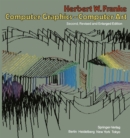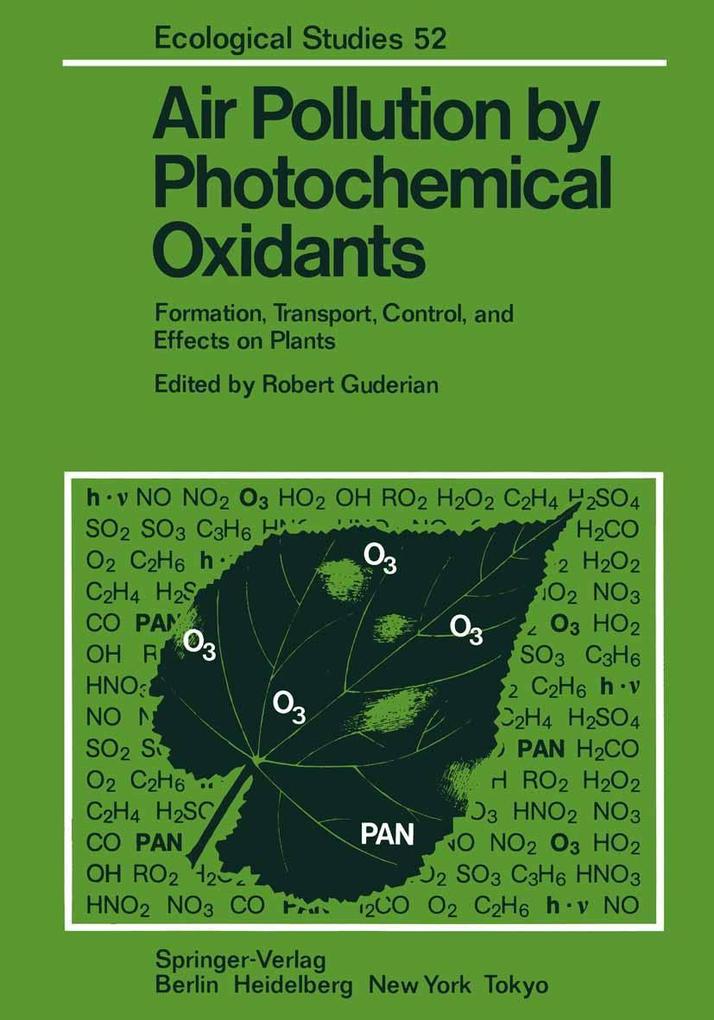
Air Pollution by Photochemical Oxidants : Formation, Transport, Control, and Effects on Plants - neues Buch
ISBN: 9783642701184
Photochemical oxidants are secondary air pollutants formed under the influence of sunlight by complex photochemical reactions in air which contains nitrogen oxides and reactive hydrocarbo… Mehr…
| hive.co.uk No. 9783642701184. Versandkosten:Instock, Despatched same working day before 3pm, zzgl. Versandkosten. Details... |

Air Pollution by Photochemical Oxidants - neues Buch
ISBN: 9783642701184
Photochemical oxidants are secondary air pollutants formed under the influence of sunlight by complex photochemical reactions in air which contains nitrogen oxides and reactive hydrocarbo… Mehr…
| Springer.com new in stock. Versandkosten:zzgl. Versandkosten. (EUR 0.00) Details... |

ISBN: 9783642701184
Air Pollution by Photochemical Oxidants - Formation Transport Control and Effects on Plants: ab 128.49 € eBooks > Sachthemen & Ratgeber > Technik Springer Berlin Heidelberg eBook als pdf,… Mehr…
| eBook.de Versandkosten:in stock, , , DE. (EUR 0.00) Details... |

Air Pollution by Photochemical Oxidants : Formation, Transport, Control, and Effects on Plants - neues Buch
ISBN: 9783642701184
; PDF; Scientific, Technical and Medical > Biology, life sciences > Life sciences: general issues > Ecologi, Springer Netherlands
| hive.co.uk No. 9783642701184. Versandkosten:Instock, Despatched same working day before 3pm, zzgl. Versandkosten. Details... |

Air Pollution by Photochemical Oxidants - neues Buch
2012, ISBN: 9783642701184
Formation, Transport, Control, and Effects on Plants, eBooks, eBook Download (PDF), [PU: Springer Berlin Heidelberg], Springer Berlin Heidelberg, 2012
| lehmanns.de Versandkosten:Download sofort lieferbar. (EUR 0.00) Details... |


Air Pollution by Photochemical Oxidants : Formation, Transport, Control, and Effects on Plants - neues Buch
ISBN: 9783642701184
Photochemical oxidants are secondary air pollutants formed under the influence of sunlight by complex photochemical reactions in air which contains nitrogen oxides and reactive hydrocarbo… Mehr…
Robert Guderian; K.H. Becker; W. Fricke; R. Guderian; J.L. Löbeö; R. Rabe; U. Schurath; D.T. Tingey:
Air Pollution by Photochemical Oxidants - neues BuchISBN: 9783642701184
Photochemical oxidants are secondary air pollutants formed under the influence of sunlight by complex photochemical reactions in air which contains nitrogen oxides and reactive hydrocarbo… Mehr…

ISBN: 9783642701184
Air Pollution by Photochemical Oxidants - Formation Transport Control and Effects on Plants: ab 128.49 € eBooks > Sachthemen & Ratgeber > Technik Springer Berlin Heidelberg eBook als pdf,… Mehr…

Air Pollution by Photochemical Oxidants : Formation, Transport, Control, and Effects on Plants - neues Buch
ISBN: 9783642701184
; PDF; Scientific, Technical and Medical > Biology, life sciences > Life sciences: general issues > Ecologi, Springer Netherlands
Air Pollution by Photochemical Oxidants - neues Buch
2012, ISBN: 9783642701184
Formation, Transport, Control, and Effects on Plants, eBooks, eBook Download (PDF), [PU: Springer Berlin Heidelberg], Springer Berlin Heidelberg, 2012
Bibliographische Daten des bestpassenden Buches
| Autor: | |
| Titel: | |
| ISBN-Nummer: |
Detailangaben zum Buch - Air Pollution by Photochemical Oxidants
EAN (ISBN-13): 9783642701184
Erscheinungsjahr: 2012
Herausgeber: Springer Berlin Heidelberg
Buch in der Datenbank seit 2016-12-05T14:31:20+01:00 (Berlin)
Detailseite zuletzt geändert am 2023-05-19T21:27:36+02:00 (Berlin)
ISBN/EAN: 9783642701184
ISBN - alternative Schreibweisen:
978-3-642-70118-4
Alternative Schreibweisen und verwandte Suchbegriffe:
Autor des Buches: guderian, robert becker, fricke, guderia, herbert franke
Titel des Buches: pollution control, air pollution photochemical oxidants
Daten vom Verlag:
Autor/in: Robert Guderian
Titel: Ecological Studies; Air Pollution by Photochemical Oxidants - Analysis and Synthesis; Formation, Transport, Control, and Effects on Plants
Verlag: Springer; Springer Berlin
348 Seiten
Erscheinungsjahr: 2012-12-06
Berlin; Heidelberg; DE
Sprache: Englisch
96,29 € (DE)
99,00 € (AT)
118,00 CHF (CH)
Available
XII, 348 p.
EA; E107; eBook; Nonbooks, PBS / Biologie/Ökologie; Ökologie, Biosphäre; Verstehen; Air; Air pollution; emissions; pollution; vegetation; ecotoxicology; C; Ecology; Ecotoxicology; Agriculture; Forestry; Geoecology/Natural Processes; Nature Conservation; Ecology; Environmental Chemistry; Agriculture; Forestry; Earth System Sciences; Conservation Biology; Biomedical and Life Sciences; Umweltchemie; Agrarwissenschaften; Forstwirtschaft und Waldbau: Praxis und Techniken; Geowissenschaften; Umweltschutz; BB
1 Formation, Transport, and Control of Photochemical Oxidants.- 1.1 Introduction.- 1.2 Oxidants, Precursors, and Concomitant Species.- 1.2.1 Individual Compounds.- 1.2.2 Physieochemical Properties of Important Oxidants.- 1.2.2.1 Ozone.- 1.2.2.2 Peroxyacyl Nitrates.- 1.2.2.3 Hydrogen Peroxide.- 1.2.2.4 Nitrogen Dioxide.- 1.2.3 Physicochemical Properties of Important Precursors and Concomitant Species of Photochemical Oxidants.- 1.2.3.1 Nitric Oxide.- 1.2.3.2 Hydrocarbons.- 1.2.3.3 Aldehydes and Ketones.- 1.2.3.4 Aerosols.- 1.3 Emissions and Ambient Air Concentrations.- 1.3.1 Emissions.- 1.3.1.1 Transportation.- 1.3.1.2 Industry.- 1.3.1.3 Power Plants.- 1.3.1.4 Domestic Heating and Small Trade.- 1.3.1.5 Natural Sources.- 1.3.2 Immissions.- 1.3.2.1 Natural Background Concentrations.- 1.3.2.2 Measurements in Densely Populated and Peripheral Areas.- 1.3.2.2.1 Federal Republic of Germany.- 1.3.2.2.2 European Countries and Overseas.- 1.3.2.2.3 Mobile Measurements and Special Investigations.- 1.4 Air Chemistry and Dispersion.- 1.4.1 Physicochemical Basis of Atmospheric Chemistry.- 1.4.2 Simulation.- 1.4.2.2 Chemical Models.- 1.4.2.3 Isopleth Models.- 1.4.3 Effects of Meteorological Parameters on the Formation of Oxidants.- 1.4.4 Dispersion and Transport Modeling.- 1.4.4.1 Empirical Approach: Maximum Ozone Isopleths.- 1.4.4.2 Wind Tunnel Modeling.- 1.4.4.3 Meteorological Dispersion Models.- 1.4.4.4 Box Models.- 1.4.4.5 Eulerian Models.- 1.4.4.6 Lagrangian Models.- 1.4.4.7 Modeling Ozone Formation in Power Plant Plumes.- 1.5 Surveillance of Ambient Air Quality.- 1.5.1 Analytical Techniques.- 1.5.1.1 Determination of Precursors in Ambient Air.- 1.5.1.1.1 Nitrogen Oxides.- 1.5.1.1.2 Hydrocarbons.- 1.5.1.1.3 Aldehydes.- 1.5.1.2 Determination of Oxidants.- 1.5.1.2.1 Ozone.- 1.5.1.2.2 Peroxyacetyl Nitrate (PAN).- 1.5.1.2.3 Nitric Acid, Nitrous Acid, and Aerosol Nitrate.- 1.5.2 Monitoring Policy.- 1.5.2.1 Key Oxidants and Other Pollutants Which Should Be Monitored..- 1.5.2.2 Monitoring Sites and Monitoring Periods.- 1.5.2.3 Data Evaluation.- 1.6 Abatement Strategies.- 1.7 Summary and Final Conclusions.- 1.8 Appendix.- References.- 2 Effects of Photochemical Oxidants on Plants.- 2.1 Introduction.- 2.2 Mode of Action.- 2.2.1 Pollutant Uptake.- 2.2.1.1 Pollutant Uptake into Leaves.- 2.2.1.1.1 Gas Phase Conductance.- 2.2.1.2 Pollutant Uptake by Plant Canopies.- 2.2.2 Perturbation.- 2.2.3 Homeostasis.- 2.2.4 Injury.- 2.2.4.1 Ultrastructural Changes.- 2.2.4.2 Nitrogen Metabolism.- 2.2.4.3 Carbohydrate Metabolism.- 2.2.4.4 Stress Metabolism.- 2.2.4.5 Photosynthesis.- 2.2.4.6 Respiration.- 2.2.4.7 Senescence.- 2.2.5 Effects on Plant Communities and Ecosystems.- 2.2.5.1 Reactions of Plant Communities Related to Air Pollutant Concentrations.- 2.2.5.1.1 High Pollution Dosage.- 2.2.5.1.2 Intermediate Pollution Dosage.- 2.2.5.1.3 Low Pollution Dosage.- 2.2.5.2 Causes for Observed Responses in Plant Communities.- 2.2.5.3 Effects on Semi-Natural and Agro-Ecosystems.- 2.2.5.3.1 Damage Responses in Agriculture and Horticulture.- 2.2.5.3.2 Effects on Semi-Natural and Forest Ecosystems.- 2.2.5.3.3 Symbionts and Plant Pathogens.- 2.2.5.4 Community and Economic Consequences of Functional Disruptions in Ecosystems.- 2.2.6 Effects on Lower Plants and Microorganisms.- 2.2.6.1 Ferns.- 2.2.6.2 Mosses and Lichens.- 2.2.6.3 Algae.- 2.2.6.4 Fungi.- 2.2.6.5 Bacteria.- 2.3 Diagnosis, Surveillance, and Estimation of Effects.- 2.3.1 Methods of Diagnosis.- 2.3.1.1 Analysis of Visible Injury Symptoms.- 2.3.1.1.1 Symptoms of Ozone Injury.- 2.3.1.1.2 Symptoms of PAN Injury.- 2.3.1.2 Subtle Injury.- 2.3.1.3 Investigations of Species Specific Resistance Relationships….- 2.3.1.4 Air Monitoring.- 2.3.2 Bioindicator Plants.- 2.3.2.1 Bioindicator Methods.- 2.3.2.1.1 Passive Monitoring.- 2.3.2.1.2 Active Monitoring.- 2.3.2.2 Bioindicator Results from Yarious Countries.- 2.3.2.3 Comparison of Biological and Physicochemical Methods.- 2.3.2.4 Conclusions for the Use of Bioindicators.- 2.3.3 Classification and Evaluation of Effects.- 2.3.3.1 Classification of Effects.- 2.3.3.2 Evaluation of Effects.- 2.3.4 Experimental Approaches to Determine Air Pollution Effects.- 2.3.4.1 Criteria for Selecting Experimental Methods.- 2.3.4.2 Experimental Procedures.- 2.3.4.2.1 Studies Under Natural Conditions.- 2.3.4.2.2 Studies Under Semi-Natural Conditions.- 2.3.4.2.3 Studies in Managed and Controlled Conditions.- 2.3.4.3 Summary Evaluation.- 2.4 Factors Influencing Plant Responses.- 2.4.1 Concentration and Duration of Exposure.- 2.4.2 Significance of External Growth Factors on Plant Sensitivity.- 2.4.2.1 Climatic Factors.- 2.4.2.1.1 Light.- 2.4.2.1.2 Temperature.- 2.4.2.1.3 Relative Humidity.- 2.4.2.2 Soil and Nutrition.- 2.4.2.2.1 Soil Water Content.- 2.4.2.2.2 Elevated Salt Concentrations in the Soil Solution.- 2.4.2.2.3 Plant Nutrients.- 2.4.3 Significance of Internal Growth Factors on Plant Sensitivity.- 2.4.3.1 The Influence of Developmental Stage and Leaf Age.- 2.4.3.1.1 Leaf Age.- 2.4.3.1.2 Developmental Stage.- 2.4.3.2 Species, Cultivar, and Individual Plant Resistance.- 2.4.3.2.1 Criteria to Evaluate Resistance.- 2.4.3.2.2 Relative Ozone Sensitivity.- 2.4.3.2.3 Relative PAN Sensitivity.- 2.4.3.2.4 Differential Cultivar Sensitivity.- 2.4.4 Measures to Reduce Pollutant Effects in Plant Stands.- 2.4.4.1 Differential Resistance as a Basis for Remedial Measures.- 2.4.4.2 Fertilization, Irrigation, and Cultural Methods as Protective Measures.- 2.4.4.3 Protectants Against Photochemical Oxidants.- 2.4.4.3.1 Antioxidants.- 2.4.4.3.2 Biocides.- 2.4.4.3.3 Growth Regulators.- 2.4.4.3.4 Other Chemicals.- 2.4.4.3.5 Summary of the Practicality of Chemical Protectants.- 2.5 Effects of Pollutant Combinations.- 2.5.1 Pollutant Combinations.- 2.5.2 Ozone and Sulfur Dioxide.- 2.5.2.1 Mode of Action.- 2.5.2.1.1 Pollutant Uptake.- 2.5.2.1.2 Perturbation.- 2.5.2.1.3 Injury.- 2.5.2.2 Effects on Plants.- 2.5.2.2.1 Foliar Injury.- 2.5.2.2.2 Growth Effects.- 2.5.2.3 Diagnosis of Effects.- 2.5.2.4 Factors Influencing Plant Response.- 2.5.2.4.1 Concentration and Duration..- 2.5.2.4.2 Significance of External Growth Factors.- 2.5.2.4.3 Significance of Internal Growth Factors.- 2.5.3 Ozone and Other Pollutants.- 2.5.3.1 Ozone and Nitrogen Dioxide.- 2.5.3.2 Ozone and Hydrogen Sulfide.- 2.5.3.3 Ozone and Heavy Metals.- 2.5.4 PAN and Other Pollutants.- 2.5.5 Ozone, Sulfur Dioxide, and Acid Precipitation — the Cause of Forest Decline in Central Europe?.- 2.5.5.1 Symptoms, Intensity, and Distribution of Injury.- 2.5.5.1.1 Fir.- 2.5.5.1.2 Spruce.- 2.5.5.2 Investigations into the Cause of the Forest Injury.- 2.5.5.2.1 Natural and Silvicultural Influences as Factors in the Cause of Forest Injury and Tree Death.- 2.5.5.2.2 Air Pollutants as the Cause of the Injury.- 2.5.6 Summary.- 2.6 Dose-Response Relationships.- 2.6.1 Dose-Effect Values from Gas Exposure Studies and Surveys in Pollutant-Impacted Areas.- 2.6.1.1 Dose-Effect Values from Pollutant Exposures.- 2.6.1.2 Dose-Effect Values from Field Studies and Pollutant-Impacted Areas.- 2.6.2 Methods to Derive Limiting Factors.- 2.6.2.1 Determination of Limiting Values.- 2.6.2.2 Dose Values for Definite Injury Levels.- 2.6.2.3 Ozone — Maximum Acceptable Concentrations for the Protection of Vegetation.- References.Weitere, andere Bücher, die diesem Buch sehr ähnlich sein könnten:
Neuestes ähnliches Buch:
9783871396649 Air Pollution by Photochemical Oxidants. Formation, Transport, Control, and Effects on Plants. ( = Ecological Studies, 52) . (Guderian, Robert ( Ed. ))
- 9783871396649 Air Pollution by Photochemical Oxidants. Formation, Transport, Control, and Effects on Plants. ( = Ecological Studies, 52) . (Guderian, Robert ( Ed. ))
- 9780444885425 Air Pollution by Photochemical Oxidants (AIr Quality Monographs) (Colbeck, I. MacKenzie, A.R.)
- 9783642701207 Air Pollution by Photochemical Oxidants (Robert Guderian)
- 9780387139661 Air Pollution by Photochemical Oxidants: Formation, Transport, Control, and Effects on Plants (Ecological Studies) (Guderian, R (ed))
- 9783540139669 Air Pollution by Photochemical Oxidants: Formation, Transport, Control, and Effects on Plants (Ecological Studies, 52) (Guderian, R (Ed.))
< zum Archiv...

